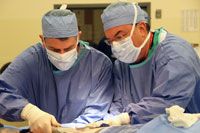Pets and Vets: Veterinary and human doctor partner to treat burned horse
Skin graft techniques used in human medicine utilized in veterinary treatment of Northstar's wounds.

Northstar remains in the care of Dr. Samuel Hurcombe at the Ohio State Galbreath Equine Center in Columbus, Ohio, after the horse was doused in a chemical and set on fire last summer. Photo courtesy of The Ohio State University Wexner Medical Center
Ohio
Northstar, an American paint horse that suffered severe burns to almost half his body after being doused in flammable liquid and set on fire late last summer, has undergone two skin graft procedures courtesy of Larry Jones, MD, a human burn specialist at The Ohio State University Wexner Medical Center, and Samuel Hurcombe, BSc, BVMS, MS, DACVIM, DACVECC, an assistant professor of veterinary clinical sciences at the university. Hurcombe has overseen Northstar’s care since the horse arrived in Columbus Sept. 5.

Northstar had exposed bone at the base of his neck as a result of the burns, as well as skin damage from his neck to the base of his tail and along both of his sides. Veterinary experts at the university have relentlessly managed these wounds since Northstar’s arrival, conducting a series of smaller skin grafts and implanting cell cultures in the wound bed. These procedures were designed to bring top-layer skin tissue to the central area of the expansive wound bed on Northstar’s neck and shoulders, where all his skin had burned away, the university says. However, to address the large wound across Northstar’s back, Hurcombe consulted Jones.
The doctors observed one another’s surgeries and studied human and veterinary medicine journal articles to prepare for the collaboration, deciding together that Northstar would undergo two large skin graft surgeries. Led by Jones, the team worked together to meet challenges such as how deep to set the tool that would peel off the donor skin. “We want to take the top layer of skin but we also need a portion of the second layer, the dermis,” Jones says. After Jones consulted with Hurcombe and the two conducted more research, “I knew I had to take a graft that’s about twice as thick as one I would take if I were operating on a human.”
The clinicians removed ultrathin sheets of skin from Northstar’s chest and belly and expanded them with a meshing tool before placing the grafts across the enormous wound spanning the horse’s back. “When the graft takes, the holes will fill in from skin cells growing from the edges,” Jones says. The team dressed the wounds with bandages containing medical-grade silver, which functions as an antibiotic, to speed healing.
Northstar, 7 years old, will likely undergo a series of additional sheet graft surgeries in the next year, just as a human patient would, to completely heal the wound. He is also being treated with gabapentin to treat the severe itching and nerve-related pain that is typical in burn patients as they recover. “It’s a slow process but even in the time we’ve been caring for him, he has made remarkable progress,” Hurcombe says. “From a welfare standpoint, his psychology is great and after what he’s gone through, the fact that he is still so trusting of people is pretty amazing.”
Northstar’s owners live in northwestern Pennsylvania, where police have investigated the burning incident as a criminal case, although no suspects have been identified. “All the owners want is for him to be happy, pain-free and able to live his life with his pasture mates,” Hurcombe says. “He is bright and alert, he interacts with people and he can eat and drink and do all the things that a horse can normally do as far as function. And he has been telling us through his behaviors that he wants to live.”
Alaska
According to the Daily News-Miner, the University of Alaska Fairbanks (UAF) is close to a partnership with Colorado State University (CSU) to jointly offer a veterinary medicine program. UAF is expected to provide the first two years of graduate-level study with CSU providing the final two. Currently, Alaska is the only state that doesn’t have a veterinary school or a partnership with an out-of-state veterinary school. Alaskans will be preferred when applying to the program. The first classes are expected to begin in 2015.
Connecticut
This June, Newtown Veterinary Specialists in Newtown, Conn., celebrated the comfort dogs that have spent time in the town’s school since the Sandy Hook Elementary School shooting Dec. 14 that left 20 students and six adults dead. More than150 residents gathered in appreciation of the 50 dogs and their handlers in attendance. The March 2013 issue of dvm360 covered the work of the K-9 Comfort Dogs from Lutheran Church Charities. Addie, a then comfort-dog-in-training, is now Sandy Hook Elementary’s permanent comfort dog.
New MexicoTwo dogs in New Mexico have contracted the bubonic plague, according to Mark Dimenna, PhD, deputy director of the state’s Environmental Health Department. The disease is spread by fleas present on rodents and rabbits. According to the U.S. Centers for Disease Control and Prevention, human plague infections continue to occur in the western United States, but significantly more cases occur in parts of Africa and Asia. Health officials are warning people to be cautious around animals that could carry infected fleas.